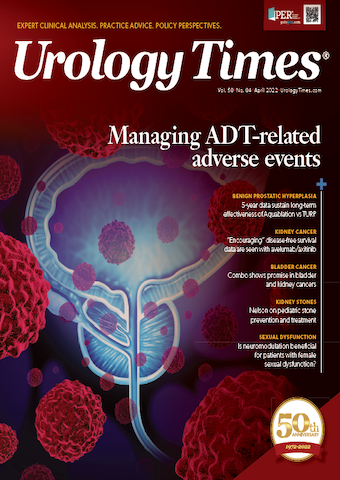Publication
Article
Urology Times Journal
Do you think patients on active surveillance would be willing to participate in a high-intensity interval exercise training program?
Author(s):
"My experience with patients who are on surveillance, who meet the criteria for active surveillance, [is that they] tend to be younger and healthier patients, so I don’t see why not," says one urologist.
Guillermo Patino, DO, FACS

“Certainly, I think it depends on the age of the patient. If you have patients on active surveillance, you can already extrapolate that a lot of them will be younger and perhaps will be in good enough shape to do a high-intensity workout. Those workouts are not for the faint of heart. They’re not for people who are not active to begin with.
Will that be possible among that group of patients? I suppose it could be.
Certainly, my experience with patients who are on surveillance, who meet the criteria for active surveillance, [is that they] tend to be younger and healthier patients, so I don’t see why not. I certainly think it’s a reasonable thing to tell them.
As far as the concept of high-intensity interval training, I would have to know more about the science behind it and how they make the science work with that.
But…some men would definitely be willing to do it. Certainly, I think a lot of the men who go on active surveillance are patients who are healthy enough to do those types of workouts. I think they would be able to, and I think if they’re willing to watch the cancer in active surveillance that they would be willing to make the effort to control it even better with high-intensity workouts. I don’t see why they wouldn’t.”
Guillermo Patino, DO, FACS
Las Vegas, Nevada
Stephanie Pothoven, DO

“Over the years, we’ve all done general urology, although I haven’t done a lot of prostate cancer for a couple years.
Certainly, I think most men with prostate cancer are very into researching prevention of recurrence and progression. So most men, if they’re physically able, would probably be interested into looking into any kind of research like that and moving forward.
It could depend on the patient’s age, comorbidities, and ability. [From] past [experience], I know a lot of men…would be willing to investigate any kind of adjuvant therapy they could find that would reduce the risks, because if they are on active surveillance, they want to keep it that way. They don’t want any progression of the disease. So if there’s something that actually gives them a little bit more ownership of their disease process, and that they can do to help prevent the cancer from progressing and having to move on to active treatment, a lot of the men would be willing to pursue it.
As far as the concept goes, prostate cancer aside, anytime you’re increasing your physical activity and increasing that cardiac stress, that’s good for every patient, [whether they have] prostate cancer, benign prostatic hyperplasia, [or] prolapse. Anything increasing your physical health overall is beneficial.”
Stephanie Pothoven, DO
Clive, Iowa
Matthew Karlovsky, MD

“The confounding factor, of course, is that people who work out are healthier and have better cardiovascular health anyway. It would be very important to separate out individuals with good cardiovascular health, normal body mass index, normal cholesterol, normal blood pressure, and no diabetes.
If men are already active, the question is how much more this activity would help them vs somebody who was marginally obese, actually lost 20 to 30 pounds, and who lowered their cholesterol.
Also, it depends on the genetics of the prostate cancer. Individuals are going to get tested. And to be honest, if those tests show less than a 1% risk of metastatic disease in 10 years, why would they go and exercise?
Because we have genetic tests, which is the genetic behavior of the cancers, this might not even have a marginal impact on the progression of the prostate cancer.
If the patient is obese, but the genes are telling him he’s low risk, what incentive has he to lose weight?
If the patient is intermediate risk and decides on watchful waiting, then loses 45 pounds due to high-intensity interval training and is suddenly determined to be low risk, that would be profound. You’d be reversing the course of the cancer by doing exercise. If gene testing already categorizes men as low risk, I don’t see the enormous incentive for them to exercise unless they are already motivated, to be honest.
It’s fine for heart health. There’s a colloquial thing we used to say: ‘Anything that’s good for the heart is good for the prostate.’
Obviously, it’s not a guarantee that solves all prostate issues but I think exercise would have marginal impact in light of the genomics that are widely available.
For sedentary individuals, if genomics show they’re low risk, it will be hard to convince them they have to work out so their prostate cancer risk will be even lower. “
Matthew Karlovsky, MD
Phoenix, Arizona
Reference
1. Kang D-W, Fairey AS, Boulé NG, Field CJ, Wharton SA, Courneya KS. Effects of exercise on cardiorespiratory fitness and biochemical progression in men with localized prostate cancer under active surveillance: the ERASE randomized clinical trial. JAMA Oncol. 2021;7(10):1487-1495. doi:10.1001/jamaoncol.2021.3067

Newsletter
Stay current with the latest urology news and practice-changing insights — sign up now for the essential updates every urologist needs.































